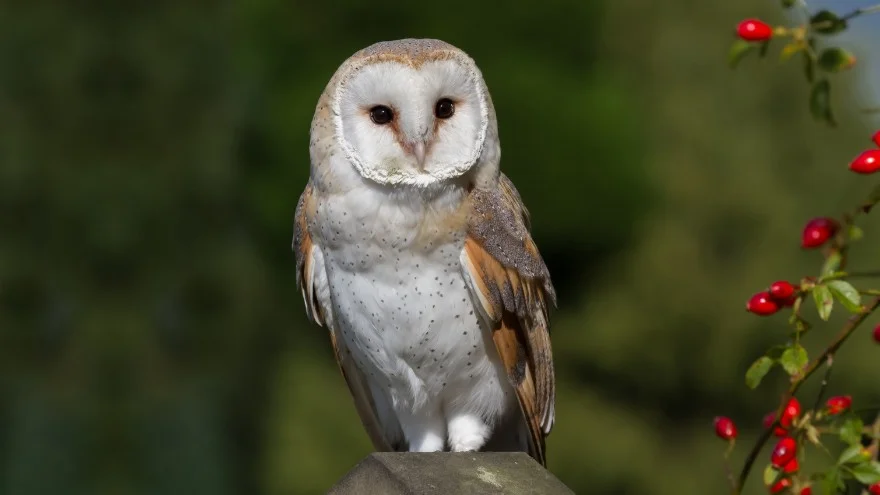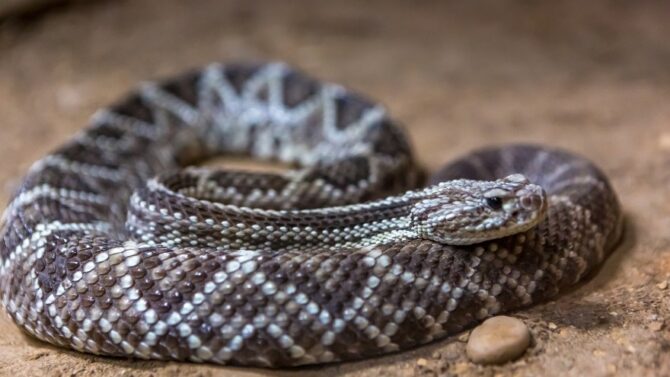Texas is often known for cowboys, horses, and folks saying “howdy?”, but there’s a lot more to the state than what the media shows.
It is in the southern region of the United States and is considered the second largest both in size and population.
There are many more animals in the state other than horses, including a variety of owls.
Some of the popular species of owls in Texas include the spotted owl, short-eared owl, great-horned owl, and barn owl, among others.
Let’s walk through more than ten owl species that live in Texas with their peculiarities and how to identify them.
Species of Owls in Texas
1. Barn Owl
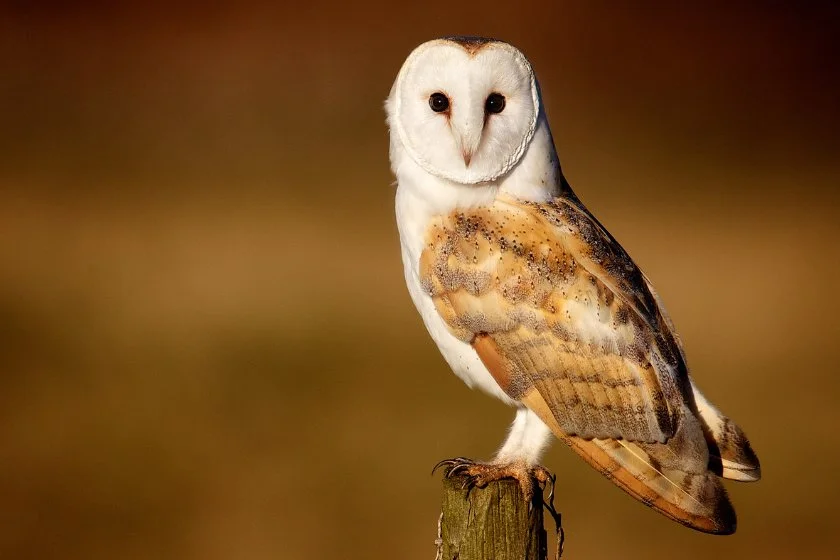
- Length: 13 to 16 inches
- Weight: 14 to 25 pounds
- Wingspan: 40 to 50 inches
- Scientific name: Tyto Alba
The barn owl got its name from living in barns and abandoned houses. It is the most widespread owl in the world and one of the most widespread birds.
Except for some regions like the polar and deserts, you can find these birds everywhere. They are found year-round in Texas and are non-migratory.
The face is heart-shaped and the entire plumage is sandy-colored with brown edges. The face is important as it helps them hear better.
It moves sound to their ears, which they use to hunt. With the ears, barn owls can easily locate hidden small animals, even bats.
Other physical features include long wings, a short tail, and a medium size. Because they have faces like ghosts, barn owls are feared, possibly more than other species.
Due to this, they are sometimes called ghost owls or demon owls. However, the bird is relatively harmless.
It also bears the name church owl because it sometimes stays in abandoned churches, and monkey-faced owl because of its looks.
There are three lineages of barn owls: the western, eastern, and American. The latter is the lineage that resides in Texas, mainly in open environments.
This bird is a carnivore, feeding on mainly small mammals. It is also called the common barn owl.
2. Great-horned Owl
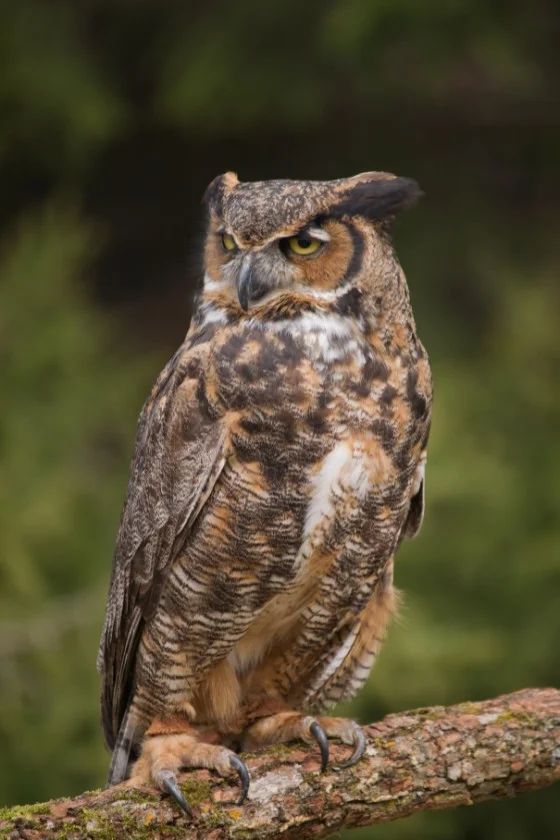
- Length: 18 to 25 inches
- Weight: 32 to 88 pounds
- Wingspan: 40 to 57 inches
- Scientific name: Bubo virginianus
The great horned owl is considered one of the largest owls in the Americas, found in different parts of the continent.
It can be found all year round in Texas and it is the biggest among all birds on this list. This species is also called the tiger or hoot owl.
The great horned owl is very adaptable and widespread across the Americas. A greater number are in the North, some are in the South and a few are in Central America.
Its habitats are numerous, including deserts, tropical rainforests, mangrove swamps, pampas, and rocky coasts.
The great horned owl has light underparts with the upper parts being mottled brown. This color combination helps with camouflage.
The bird also has long tufts and a piercing look. Hooting is its main sound (as evidenced by the name hoot owl), with the males having a lower pitch.
The primary diet of this bird is rodents, but it can also go after reptiles, birds, and slightly bigger mammals.
Animals it hunts include rabbits, voles, and hares. It employs camouflage to its benefit and is more active during the night.
3. Spotted Owl

- Length: 18 to 25 inches
- Weight: 32 to 88 pounds
- Wingspan: 40 to 57 inches
- Scientific name: Strix occidentalis
The spotted owl is somewhat rare compared to others on this list. Its population is declining due to habitat loss, and it has been classified as near threatened.
In Texas, you can only find these birds in western forests. With deforestation being a problem, the spotted owl faces danger.
This bird is so named because of the marks all over its body. It is similar to the barred owl, but the markings are different for both birds. Competition with the barred owl is another reason for the decline of the spotted owl.
Besides its looks, another way to spot this bird (no pun intended) is to listen for its hooting. The spotted owl makes a soft hoot that makes four notes.
It also makes additional sounds like grunts, groans, and chatters. These sounds can be used to protect territories and communicate.
In their little corner in Texas, they still thrive. They are just as carnivorous as other owls, consuming reptiles, birds, and smaller mammals. It is a nocturnal bird with three subspecies currently recognized.
4. Short-eared Owl
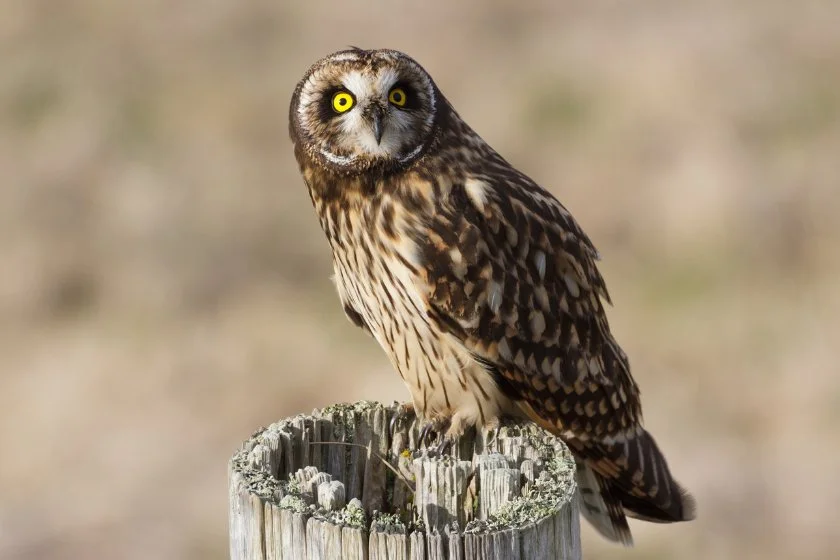
- Length: 14 to 17 inches
- Weight: 7 to 17 pounds
- Wingspan: 34 to 41 inches
- Scientific name: Asio flammeus
The short-eared owl is named so because of the little ear tufts perched on its head. It spends most of its summer in Canada and other states in the United States, usually the north. It only comes down to Texas and other southern states during the winter.
This is a medium-sized bird with a mottled tawny to brown plumage, a large head, big eyes, a short neck, and spread-out wings.
The females are often bigger than the males, and there are always black rings circling both eyes.
From a distance, you might think it wears mascara. Its call sounds almost like a bark, though it tends to be silent more than other owls.
In many regions, you can find a short-eared owl in grasslands, meadows, and woodland areas. Its main diet includes rats, shrews, mice, voles, and small birds.
5. Barred Owl
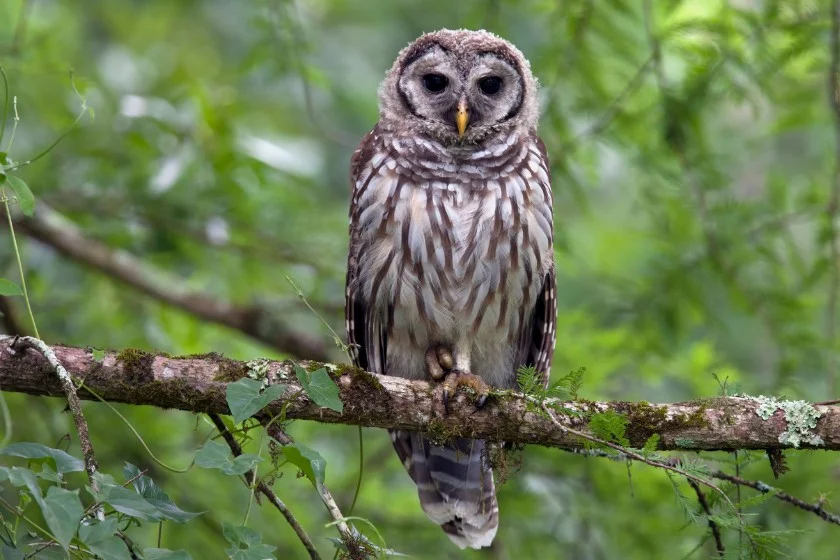
- Length: 17 to 20 inches
- Weight: 16 to 37 pounds
- Wingspan: 39 to 43 inches
- Scientific name: Strix varia
The barred owl is also called the hoot owl, striped owl, and northern barred owl. It is usually found in the eastern parts of North America but has since moved to other areas.
In Texas, it stays on the eastern side. Preferred habitats include mature, deciduous, coniferous, and mixed forests.
Just as we pointed out above, the barred owl is similar to the spotted owl, such that it may be easy to confuse one with the other.
However, the barred owl is bigger than its spotty counterpart, and it has stripes rather than spots. The stripes alternate between light and dark brown on the wings and tail.
This species is an opportunistic predator, so though its preferred prey seems to be small mammals, it can also go after birds, reptiles, and amphibians. It is nocturnal, beginning its nightly activities after 8:00 pm.
6. Long-eared Owl

- Length: 14 to 16 inches
- Weight: 8 to 15 pounds
- Wingspan: 36 to 40 inches
- Scientific name: Asio otus
The long-eared owl differs from the short-eared species in a very obvious manner. It has long ear tufts, which is their distinctive quality.
Its migratory nature brings it to Texas, where it resides in the west. Some individuals can occasionally be found in the east too.
Both the long-eared and short-eared belong to the genus Asio, all of which are known as the eared owls.
The long-eared is also described as being slim with long wings, and it is medium-sized.
Other names for this bird are the northern long-eared owl, the lesser horned owl, or the cat owl.
As a specialized predator, it tends to focus solely on rodents. However, it can adapt to birds when rodents are lacking.
7. Northern Saw-whet Owl
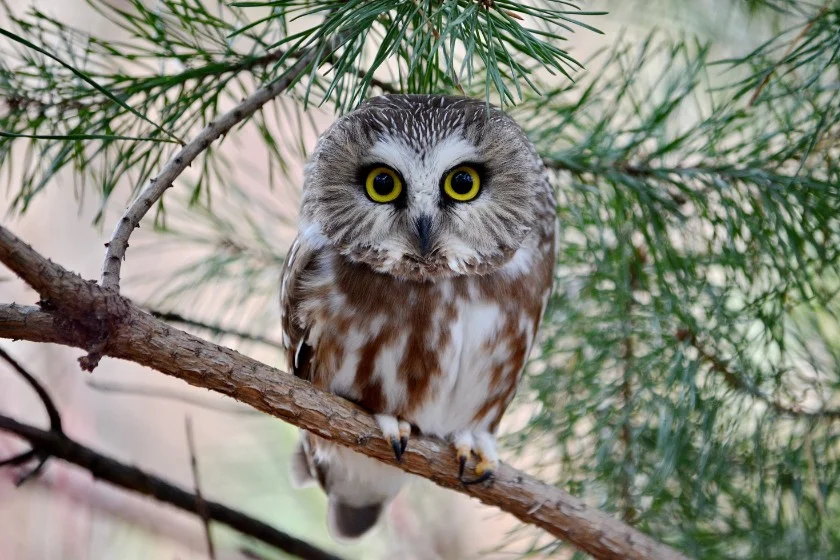
- Length: 7 to 9 inches
- Weight: 2 to 5 pounds
- Wingspan: 17 to 22 inches
- Scientific name: Aegolius acadius
The Northern saw-whet owl has a distinct sound, which can be surprising given its small size.
The bird is one of the smallest in North America, and if you come across any tiny one in Texas, chances are it is a saw-whet.
The sound is likened to a saw being sharpened on a whetstone, hence the name.
The saw-whet is described as being similar in size to a robin. Females tend to be larger than males which is perhaps the biggest difference you will find between both sexes. This bird is similar to the short-eared owl but is smaller in size.
Additional physical traits include a round face that’s both light and white, a dark beak, and yellow eyes. The face is also streaked with brown and cream.
Despite its size, the saw-whet is a carnivorous predator. It feeds mainly on small mammals, using a style of ambush and swoop. Rodents make up a large part of the diet. These owls can also be prey to bigger owls.
8. Burrowing Owl

- Length: 7 to 11 inches
- Weight: 5 to 9 pounds
- Wingspan: 20 to 24 inches
- Scientific name: Athene cunicularia
The burrowing owl is also known as the shoco, and it is named ‘burrowing’ because it makes a home out of burrows.
There are many of them in Texas, around the western and central areas of the state. Preferred habitats include meadows, fields, and pastures.
Their habit of living in burrows distinguishes the burrowing owl from other species that make a home out of trees.
Sometimes it digs the hole itself, but most often it inhabits ones abandoned by other animals like squirrels.
The advantage of living underground is that the bird has an access to many rodents.
These birds can be active both during the day and at night, though they avoid the heat. To hunt, they use their legs and wings to go after the targeted prey. They feed mainly on large insects and rodents.
9. Elf Owl
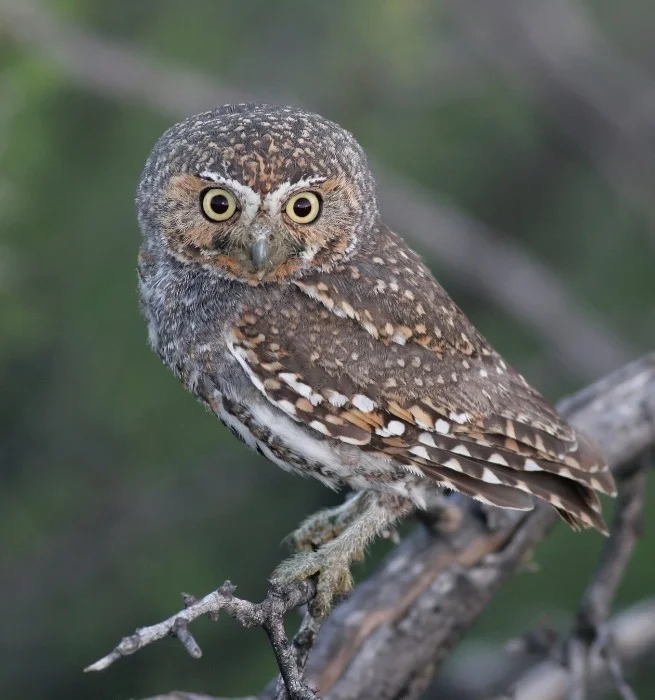
- Length: 5 to 6 inches
- Weight: 2 pounds
- Wingspan: 11 inches
- Scientific name: Micrathene whitneyi
The elf owl is considered the world’s smallest owl, as well as the lightest. There are only two other birds that are known to be close to the elf in size, the long-whiskered owlet, and the Tamaulipas pygmy owl.1
The elf owl is recognized by its fairly long legs. It is migratory and appears in Texas during the summer.
The elf owl is often compared to a sparrow in size. It also has long legs which might seem bow-legged. Its call sounds like a chuckle or whinnying, and the best way to know it is around is to listen to it.
It usually builds its nest in a cactus to prevent predators from getting close. Unfortunately for it, the cactus doesn’t stop other owls.
Due to its small size, this bird feeds mainly on insects like centipedes, moths, and beetles. It isn’t limited to that, however. Scorpions can also fall prey.
The elf owl is also good prey to many animals, and it developed some methods to protect itself. One such way is to play dead so the predator can relax, giving it time to escape.
10. Western Screech Owl
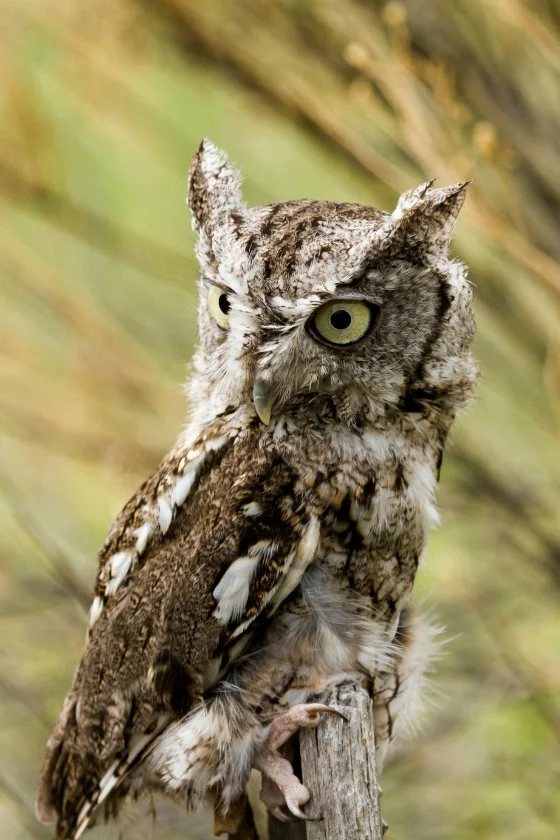
- Length: 8 to 10 inches
- Weight: 4 to 11 pounds
- Wingspan: 22 to 25 inches
- Scientific name: Megascops kennicottii
The western screech owl is closely related to the eastern screech owl, and they both are alike. Given that you can find these two birds in Texas, the only sure way to differentiate both is through the vocals. They have different sounds.
The western screech owl’s call is more of a trill than a screech, though it can do the latter in a high-pitched manner.
The eastern screech owl doesn’t screech (despite its name) but makes a host of other sounds like whinnies and a soft trill.
The western screech feeds mainly on small mammals like mice or rats. It can also feed on insects, and because of its opportunistic nature, it won’t miss the chance to go against birds, scorpions, and crayfish.
11. Flammulated Owl
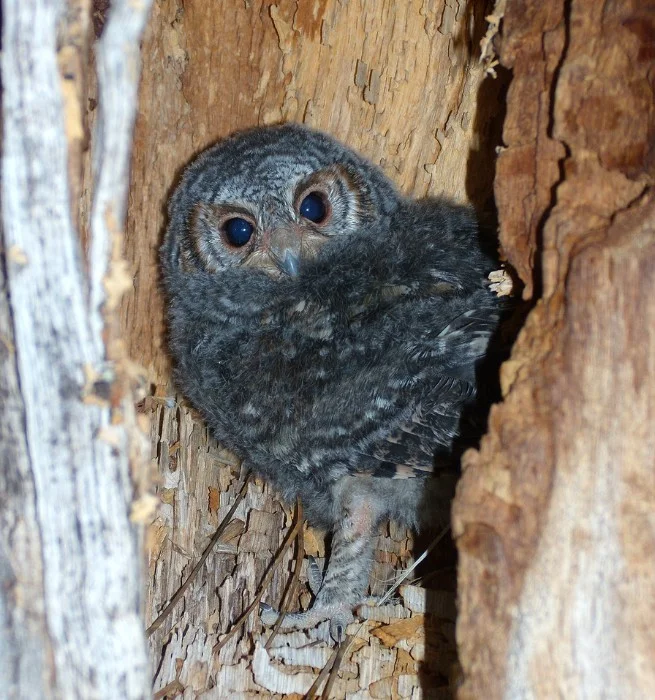
- Length: 6 to 7 inches
- Weight: 1.5 to 2 pounds
- Wingspan: 15 to 16 inches
- Scientific name: Psiloscops flammeolus
The flammulated owl is the only species in its genus Psiloscops. It is known for its small size and migratory nature, earning it its full name. This bird can be found in the south, west, and east of Texas.
This owl is called “flammulated” because it has markings that look a lot like flames. These markings help it camouflage in its habitat.
Alongside the size, you might find it hard to see this creature. The best place to look is in deciduous forests where it nests.
The flammulated owl is nocturnal, and in appearance, it somehow looks like the western screech.
It is also compared to other small birds like the elf owl and the mountain pygmy. It feeds on mostly insects but can supplement that with small mammals.
12. Snowy Owl
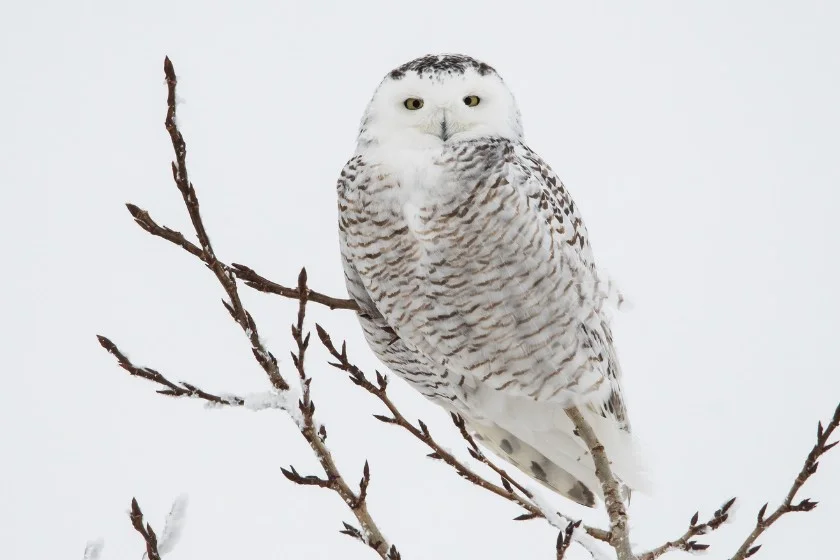
- Length: 21 to 28 inches
- Weight: 56 to 104 pounds
- Wingspan: 50 to 57 inches
- Scientific name: Bubo scandiacus
The snowy owl is a nomadic creature that’s best known for its striking white color. It is also known as the polar, the Arctic, or the white owl.
As all the names imply, it is native to the arctic regions of North America and the Palearctic.
Because it is nomadic, it is hardly found in Texas. When it does come to the state, it usually is on the northern side.
Males usually have pure white plumage while females have some streaks of dark brown.
These birds are also large but have relatively small heads. Their eyes are yellow, and they are whiter than polar bears. The snowy owl is a sight to behold.
The snowy owl is a large predator that can hunt both during the day and at night.
It is often active during the day, so whenever it migrates to Texas, you can get the chance to see it. It feeds on small mammals but is opportunistic enough to eat carrion.
13. Ferruginous Pygmy Owl
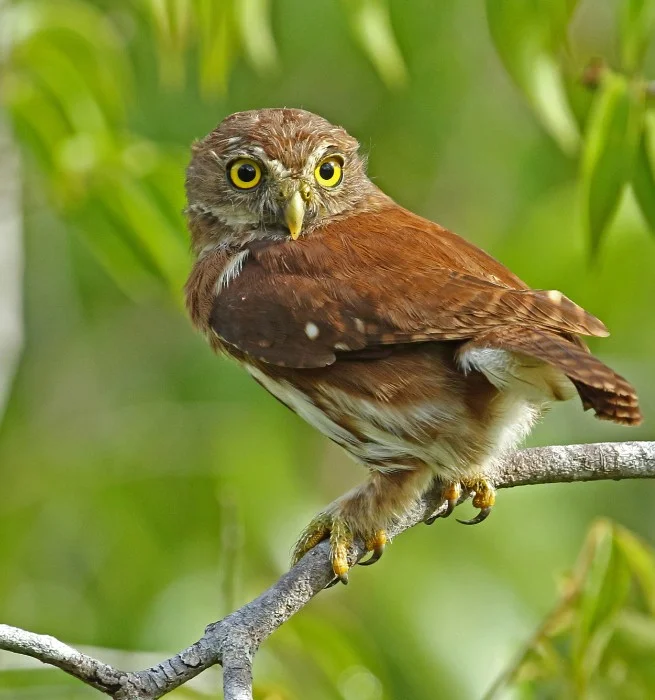
- Length: 6 inches
- Weight: 2 to 3 pounds
- Wingspan: 15 to 16 inches
- Scientific name: Glaucidium californicum
The ferruginous pygmy is common in Texas and Arizona, but less so in other parts of the United States.
It is often seen in habitats like open forests. It is a small bird (as the name shows) and is quite common in southern and Central America.
The ferruginous pygmy owl is both small and stocky, with a color that could is usually grey-brown with touches of white on the crown, underparts, and wing coverts.
The final prominent feature is two dark spots on the nape, called “false eyes”. The call goes in the form of hoo-hoo-hoo, a subtle whistle.
The bird hunts more during the day but is defined as crepuscular. Its diet is vast, going from mammals to amphibians. The prey includes crickets, grasshoppers, scorpions, skinks, and whiptails.
14. Eastern Screech Owl

- Length: 6 to 10 inches
- Weight: 4 to 9 pounds
- Wingspan: 19 to 24 inches
- Scientific name: Megascops asio
The eastern screech owl is widespread throughout the eastern parts of the United States and is similar to the western screech owl.
The differences one can notice in both creatures fall under height and vocal sounds. The eastern screech is the smaller of the duo and has a unique sound. It is common in Texas.
Both the eastern and western screech owls were once considered the same species, but further research has led to a separation of both birds as distinct species.
Physical features of the eastern screech include stockiness, a round head, ear tufts that stand out, and large feet.
The bird is nocturnal and hard to see because it typically avoids detection by humans. It can be found around the human residence, though, which gives you a better probability of seeing it.
It feeds on mainly insects during the breeding season, and other times it feeds on invertebrates. Its name is a bit of a misnomer as it doesn’t screech. Its sound is more likened to a horse.
Conclusion
There are up to 14 different species of owls in Texas, some of which remain all year while others come and go.
These creatures have their peculiarities, and regardless of some myths, they aren’t dangerous.
You could be lucky to see some in action during the day or roosting in the nest. Others are more active at night, fitting the stereotype.
Next up…
- 10 Most Dangerous Animals In Texas That Are Deadly
- 15 Most Dangerous Animals In The United States
- Wildlife In America – Native Animals In The United States
References & Notes
- BirdNote. 2017. Meet the Tiniest Owl in the World. Audubon.
